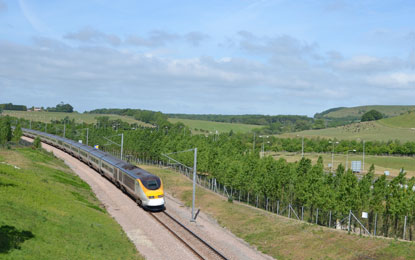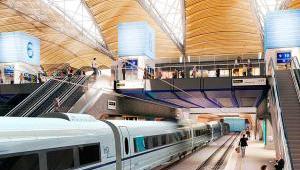The economic benefit of building the UK’s only existing high-speed rail line will not be big enough to meet the cost of the project, it has been revealed today.
 The National Audit Office said that the construction of High Speed 1, the 109km line that connects London St Pancras with the Channel Tunnel, did not represent value for money, due to lower-than-expected passenger numbers.
The National Audit Office said that the construction of High Speed 1, the 109km line that connects London St Pancras with the Channel Tunnel, did not represent value for money, due to lower-than-expected passenger numbers.Auditors estimate that the £7bn economic value of quicker journeys on the line for the 60 years to 2070, will be less than the total cost to taxpayers over the same period.
Total costs have been estimated at £10.2bn, even when deducting the £2.1bn made from selling the right to operate the line for 30 years to two Canadian pension funds.
The NAO found that the numbers of international passengers using Eurostar services on the line is below forecast, coming in around one-third less than the government predicted in 1998 when proposing the line.
The value-for-money assessment excluded other benefits, such as reduced crowding on some trains and improved reliability, and the impact of regeneration.
Although the NAO said these ‘would have a significant value’, most are unmeasurable, making it impossible to reach a clear conclusion on their values. However, they would need be worth at least £3.2bn to exceed the costs, and would be required to hit £8.3bn to meet the ratio of benefits to cost of 1.5:1, which was predicted by the Department for Transport at the project’s inception.
The DfT told auditors that it intends to review regeneration benefits after the 2012 Olympic Games when the legacy plan for the Olympic Park has been implemented. The site will be served by HS1, with a station at Stratford, but the NAO said that an evaluation plan should already be in place if the government wants to ‘measure robustly the impact of the project’.
Construction of the line, which is also used to provide commuter services to London from five stations in the south of England, also cost more than planned. Although it was delivered within the overall funding available, the £6.2bn overall cost was 18% higher than the contract target, the NAO said.
However, the report concluded that the sale of the right to operate the line to Borealis Infrastructure and the Ontario Teachers’ Pension Planin November 2010 was ‘well-managed’, ending ‘open-ended’ taxpayer support.
Auditor general Amyas Morse said: ‘The High Speed 1 project has brought a number of significant benefits including quicker journey for passengers.
‘However, the project went forward on the basis of hugely optimistic assumptions about international passenger numbers. These were not realised and the department is only now developing its plan to evaluate whether the project was value for money.’
The assessment of the project comes as the government presses ahead with proposals for a second high speed rail line between London and Birmingham. This project also includes the economic benefits of savings on travel time in its calculations to achieve a ratio of benefit to cost of 1.4, lower than that expected of HS1.
Responding to the report, a DfT spokesman insisted it had ‘significantly improved its passenger forecast modelling since the original work for HS1 some 20 years ago’.
He added: ‘HS1 was delivered on time and on budget and this report points to the significant benefits it has achieved, not just for passengers, but for the taxpayer including when it was sold for more than £2bn, far exceeding market expectations.’




















